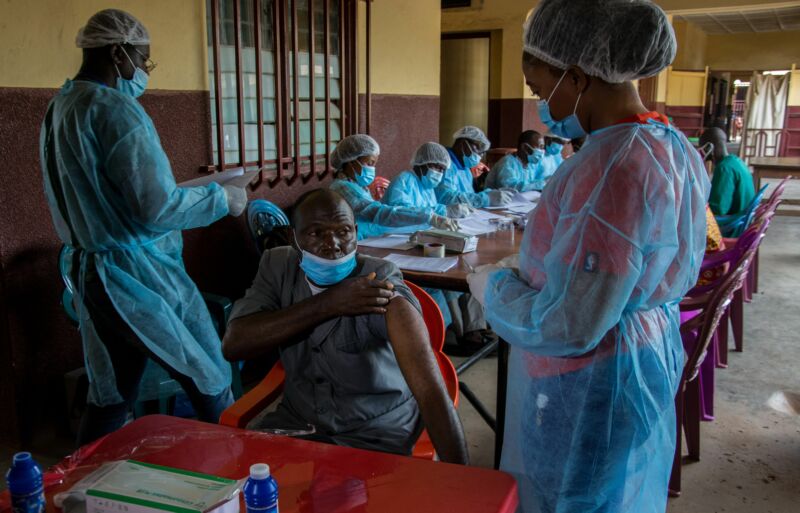Long play —
Ebola virus is known to persist in some survivors—but not for this long.
Beth Mole
–

Enlarge / A staff member of the N’zerekore hospital lifts his shirt sleeve as he prepares to get his anti-ebola vaccination in N’zerekore on February 24, 2021. Nzerekore Hospital was where the first cases of Ebola were found at the end of January 2021.
The Ebola viruses behind a new outbreak in Guinea are stunningly similar to viruses identified during the massive West Africa outbreak that spanned 2013 to 2016, according to a new genetic analysis. The finding suggests that virus may have silently persisted in a survivor for at least five years and that the current outbreak was sparked by that unlucky person, rather than a spillover from an animal reservoir.
In the genetic analysis posted online Friday, a group of international researchers report that Ebola viruses collected from the current outbreak in Guinea have only a dozen or so genetic differences from Ebola variants collected from the same area of Guinea in 2014. Based on what researchers know about the pace at which Ebola collects such genetic substitutions—its evolutionary rate—that number of accumulated differences should have totaled over 110 in that timespan, not 12.
“This number of substitutions is far less than what would be expected during sustained human-to-human transmission,” they researchers write in their analysis. Instead, they note such a sluggish evolutionary rate is a “hallmark of persistent infections.”
“Therefore, the index case of the 2021 Guinea cluster was likely infected from a persistent source, such as via sexual transmission from an [Ebola] survivor,” they conclude.
The Ebola virus is known to persist in some survivors, particularly in places where it can lay low from the immune system, such as the testicles or eyeballs. A 2016 study reported resurgence of the virus in a survivor’s seminal fluid more than 500 days after the initial infection.
Still, the more than five-year span was “shocking” to many virologists and public health experts. And it raises a variety of concerns for the many survivors of past outbreaks, some of whom may have had mild cases of Ebola without realizing it. In particular, many people known to have survived Ebola face stigmatization, and the possibility of years-long persistence is likely to amplify that problem.
In the 2013-2016 West Africa outbreak, more than 28,000 people were infected with the virus, and over 11,000 died. It is the largest Ebola outbreak in history. Most of the cases and deaths were in Guinea, Liberia, and Sierra Leone. The outbreak began with a case reported in an 18-month old boy in December 2013; the boy is believed to have caught the virus from bats.
The current outbreak, which was declared February 14, has sickened at least 18 and killed nine. Vaccination efforts are now underway to stop the spread of the virus.

